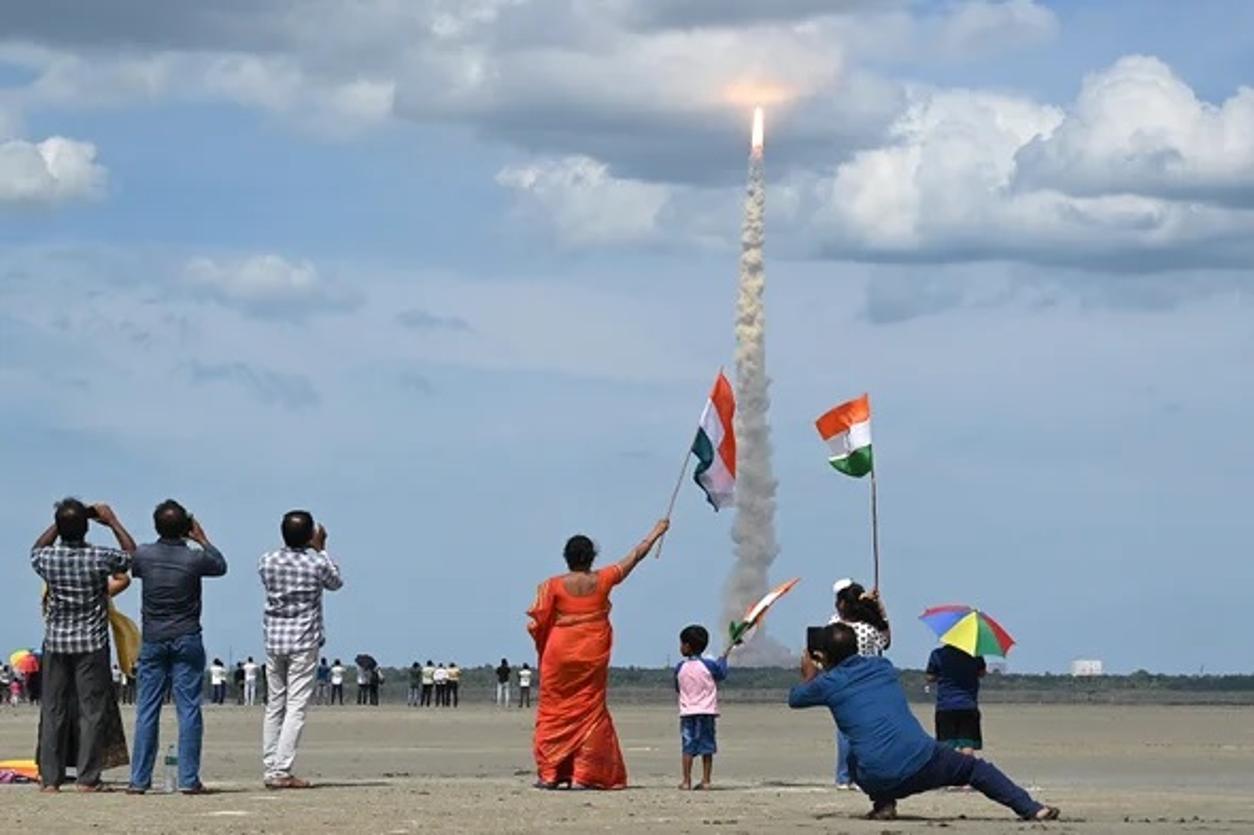The Indian Space Research Organisation (ISRO) announced the Chandrayaan-3’s lander module, christened “Vikram-3,” first moon landing on Aug. 23, 2023. The touchdown was achieved after a nail-biting descent that showcased the precision of ISRO’s navigation and control systems.
The significant milestone marks a leap forward in the nation’s space ambitions and scientific capabilities, as Chandrayaan-3 aims to gather crucial data about the lunar surface and its geological characteristics.
Less than a week has passed since India’s Chandrayaan-3 mission achieved the historic feat of landing on the Moon’s southern pole. The mission’s lander is now swiftly engaging in the collection of invaluable data from this previously uncharted lunar region.
The successful landing reaffirms India’s position as a key player in the global space community, joining an exclusive club of nations that have accomplished lunar landings.
Chandrayaan-3’s Primary Objective
Employing a temperature probe housed within the Vikram lander, Chandrayaan-3 conducted an assessment of the temperature distribution within the lunar soil at the southern pole.
The endeavor aims to enhance our comprehension of the thermal characteristics exhibited by the Moon’s exterior. An update disseminated through X (formerly known as Twitter) by the Indian Space Research Organisation (ISRO) unveiled the diverse temperature fluctuations spanning the lunar surface.
Variations were also captured through Chandra’s Surface Thermophysical Experiment, as the probe navigated through the layers of lunar soil. The mission’s scientific instruments are expected to provide insights into the Moon’s history, its evolution, and potentially shed light on Earth’s past as well.
Chandrayaan-3’s successful landing comes after the setback faced by its predecessor, Chandrayaan-2, in 2019. With the spacecraft now safely on the moon, ISRO’s efforts have paid off, and India has become the fourth country to achieve a soft lunar landing, following the former Soviet Union, the U.S. and China.
Chandrayaan-3’s Lunar Descent
Chandrayaan-3’s lunar descent had to be entirely self-directed. During this critical phase of the mission, the signals took approximately three seconds to travel from the lander to Earth and back—an interval too lengthy for ISRO engineers on Earth to effectively guide the landing in real time.
Vikram was tasked with the mission of nullifying its high orbital speed to a standstill, thereby maintaining its projected path as closely as possible until a secure touchdown was achieved. This required precise coordination of engine firings based on continuous evaluations of distance, velocity, and orientation.
In order to ensure a successful landing this time, ISRO incorporated significantly more redundancies and safety measures into Chandrayaan-3 compared to Chandrayaan-2. During an August 5 presentation outlining these alterations, ISRO’s head, S. Somanath, highlighted the enhancements made.
Nilesh Desai, the director of ISRO’s Space Applications Center (SAC) in Ahmedabad, India, remarked, “There were improvements to 21 subsystems for Chandrayaan-3. These changes have been reinforced by numerous helicopter- and crane-based ground tests.
Sankaran Muthusamy, director of the U. R. Rao Satellite Center (URSC), the ISRO center that led the construction and integration of the Chandrayaan-3 spacecraft and mission said, “We now have a tremendous responsibility to inspire India and the world at levels no less than this landing,”
Chandrayaan-3 was equipped with greater fuel reserves and an improved guidance, navigation, and control system capable of rectifying substantial deviations from the intended trajectory.
Chandrayaan-3’s lunar descent, spanning approximately 19 minutes, unfolded in four distinct phases. Commencing at a distance of 30 kilometers above the lunar surface and approximately 750 kilometers away from its intended landing location, the first phase, known as the “rough braking” phase, initiated.
During this stage, all four of the spacecraft’s 800-newton main engines were engaged for a duration of about 12 minutes. This then propelled Chandrayaan-3 to an altitude of 7 kilometers, effectively reducing its rapid horizontal velocity—originally around 1.7 kilometers per second—by approximately 80 percent.
Following this was a brief yet pivotal 10-second “attitude hold” phase. Here, the lander employed its eight smaller thrusters to achieve stabilization, allowing it to establish a steady perspective of the imminent lunar terrain, a necessity for its diverse landing sensors.
For altitude measurements, Chandrayaan-3 depended on a duo of altimeters—one utilising lasers, and the other employing microwaves. Although laser altimeters are commonly utilised by numerous lunar landers, they can occasionally yield irregular height readings, particularly when traversing rugged landscapes or sizable craters.
Explaining the choice, Priyanka Mehrotra, the lead system designer of Chandrayaan-3’s Ka-Band microwave altimeter at SAC, stated that the microwave altimeter’s broader coverage area enabled Chandrayaan-3 to more effectively accommodate abrupt shifts in altitude.
Why The South Polar Region?
The south polar region stands as a captivating focal point for researchers, primarily due to compelling indications that it harbors substantial water ice reserves nestled within its perpetually shaded sectors.
The enigmatic presence of water on the Moon holds profound implications, potentially revolutionising future space exploration endeavors.
The significance of lunar water extends beyond its mere presence, as it could serve as a valuable resource for upcoming manned missions. Astronauts, during their lunar sojourns, could potentially harness this lunar water for a myriad of purposes.
From being utilised as a crucial drinking source to its transformative potential in generating fuel and oxygen, the water stores within the lunar south pole region emerge as a game-changing element that has the capacity to reshape the nature of human activities and scientific pursuits on the Moon.
The Next Moon Mission
For its next moon mission—targeting launch before the end of this decade – India is contemplating a strategic collaboration with Japan, an active participant in the Artemis Accords.
The collaborative effort envisions the deployment of the LUPEX rover, designed to conduct a comprehensive analysis of the characteristics, prevalence, and ease of access to water ice situated at the Moon’s southern pole.
The insights derived from the LUPEX mission also have the potential to offer indispensable information for upcoming crewed ventures to the Moon, seamlessly aligning with NASA’s Artemis initiative and its ambitions to establish a human presence on our celestial neighbor.
S. Megala, deputy director of ISRO’s lunar science and exploration program. says LUPEX requires a more precise touchdown with a much bigger lander.
“Chandrayaan-3’s success will act as a stepping stone toward India building LUPEX’s lander and thus playing a key role in the future exploration of our moon,” said Megala
Prior to progressing, India’s government needs to grant official approval for the country’s participation in the initiative, a step that Japan has already taken for its own engagement.
Meanwhile, as these deliberations unfold, Japan is poised to embark on its own lunar mission: the launch of the Smart Lander for Investigating Moon (SLIM) is scheduled for August 26.
The primary objective of SLIM is to achieve a lunar touchdown later this year, showcasing innovative technologies that facilitate accurate and cost-effective lunar landings, especially in challenging terrains.






